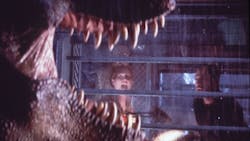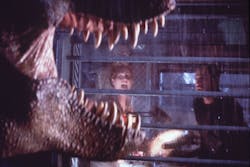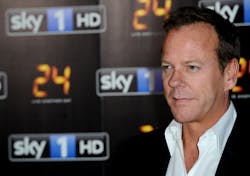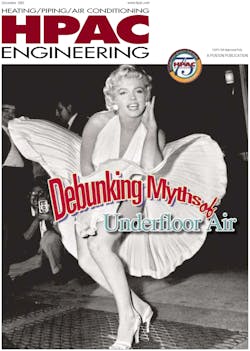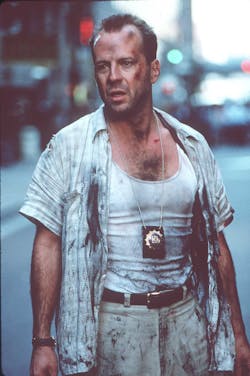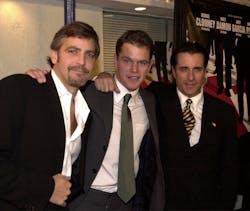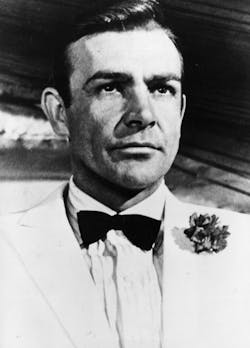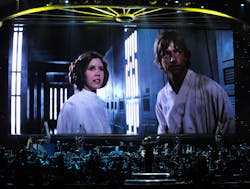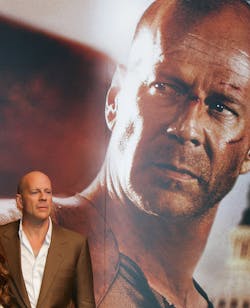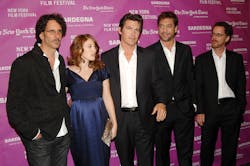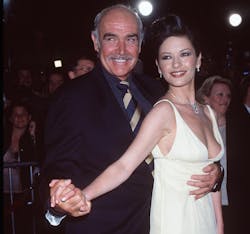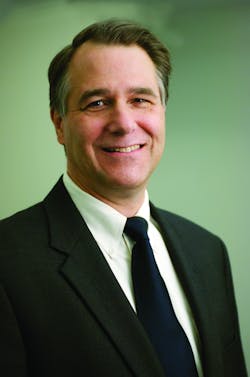HVAC in Popular Movies: Did Hollywood Get It Right?
Hollywood long has been known for—ahem—taking liberties with the truth (just ask any composite character). In this video gallery, longtime HPAC Engineering Editorial Advisory Board member Ron Wilkinson, a professional engineer who moonlights as a film critic, takes a look at 13 movies and three TV series whose makers were not about to let HVAC fundamentals get in the way of a good story.
Jurassic Park (1993)
In this Steven Spielberg-directed adaptation of Michael Crichton’s bestselling science-fiction novel, billionaire John Hammond (Richard Attenborough) secretly builds a theme park featuring cloned dinosaurs on a remote island off the coast of Costa Rica. Following the death of an employee, he brings in three unsuspecting specialists—paleontologist Alan Grant (Sam Neill), paleobotanist Ellie Sattler (Laura Dern), and chaos theorist Ian Malcolm (Jeff Goldblum)—to endorse the park and calm nervous investors. Thanks to some corporate espionage, the park’s security fences are deactivated, and the scientists, along with Hammond’s grandchildren, "Lex" and "Tim" (Ariana Richards and Joseph Mazzello), find themselves on the menu of the park’s main attractions in the middle of a tropical storm. Near the end of the film, our heroes make their way back to the park’s visitor center, where they think they are safe, but come under attack from two Velociraptors. In this sequence, Lex, Tim, and Drs. Grant and Sattler take to the nether regions of the visitor center to escape the peckish raptors. Lucky for them, the suspended ceiling is supported by a framework strong enough to support a herd of Dilophosaurus. Apparently constructed from 2-in. tool steel angle, the ceiling does not so much as flex under the weight of the thrashing refugees. The only obstacle that slows them down is the bane of all HVAC engineers: flex duct! There is yards of it, duct-taped together in a vain attempt to get makeup air to the T. rex omelette bar. It would not have been long before Hammond learned his lesson: The pressure drop of long lengths of flex duct makes air balancing harder than a Parasaurolophus pedicure.
Willy Wonka & the Chocolate Factory (1971)
In this adaptation of Roald Dahl's 1964 children's novel, “Charlie and the Chocolate Factory,” poor Charlie Bucket (Peter Ostrum) finds one of five Golden Tickets hidden among candy maker Willy Wonka’s famous Wonka Bars and receives the opportunity of a lifetime: a tour of the mysterious Wonka's Chocolate Factory. Charlie’s Grandpa Joe (Jack Albertson) accompanies him on the tour. About halfway through, as other kids in the tour group are eliminated for failing to show character under the duress of fountains of chocolate, Charlie and Grandpa Joe sneak a drink of a strange soda and are drawn into a ventilation shaft full of bubbles, up toward a menacing propeller fan. The solution? Burping, of course. As the two belch, they are gently let down, and disaster is avoided. Warning to engineers: Charlie and Grandpa Joe are trained professionals. Do not try this at your desk.
Community, Season 2, Episode 21, "Paradigms of Human Memory," and Season 3, Episode 1, "Biology 101," Episode 6, "Advanced Gay," Episode 21, "The First Chang Dynasty," and Episode 22, "Introduction to Finality" (2011-2012)
When Craig Pelton (Jim Rash), the dean of Greendale Community College, hears a mysterious thumping above the ceiling in Episode 1 (“Biology 101”) of the third season of this NBC (now Yahoo! Screen) sitcom, the study group explains it is student Troy Barnes’ (Donald Glover) pet monkey, which disappeared into an air-conditioning vent the previous season. But they know better. Soon, Ben Chang (Ken Jeong) bursts out of the ductwork in a terrycloth robe. Chang has been living in the ductwork since the college fired him for faking his credentials as a Spanish professor in Season 1. Young engineers looking for their first HVAC job should not consider this a viable housing alternative. In addition to being a bit dusty, ductwork is full of the nastiest sheet-metal screws (the sharp ends) imaginable. Perhaps someone should have informed Chang of this before he went into the duct after the monkey in Episode 21 of Season 2 (“Paradigms of Human Memory”):
24, Season 5, episodes 12 ("6:00 p.m. - 7:00 p.m.") and 13 ("7:00 p.m. - 8:00 p.m.") (2006)
Winner of the 2006 Primetime Emmy Award for Outstanding Drama Series, Season (Day) 5 of “24” sees former Counter Terrorist Unit (CTU) agent Jack Bauer (Kiefer Sutherland), who faked his death 18 months earlier, pressed back into action when his friend, former U.S. President David Palmer (Dennis Haysbert), is assassinated and three former colleagues are targeted for death. Bauer soon discovers the president, Charles Logan (Gregory Itzin), is part of a plot involving 20 canisters of VX nerve gas, which fall into the hands of terrorists. In Episode 12, the terrorists break into CTU headquarters and release a canister in the electrical room. Oddly, the electrical room is being used as an air-supply plenum for the entire building. Only the rapid closure of multiple space-age, bullet-proof, explosion-proof, airtight doors saves those in the main control room (the series’ stars). The situation worsens in Episode 13, as a corrosive agent that had been added to the gas is slowly eating away at the space-age seals. The plucky group devises a daring plan: Bauer will enter the VX-saturated area and fix the seals. Lucky for Bauer, the gas eats space-age seals, not humans. He holds his breath, runs to the failing seals, opens his official CTU emergency seal pack, and pulls out … DUCT TAPE! He quickly sticks down the duct tape, and the room is purified with fresh air in about 30 seconds. (HVAC engineers, if you don’t have a roll of duct tape in your desk, get one immediately. Be prepared.)
All that is left to do is reset the balky energy-management system and restore ventilation to the building, and CTU will be back up and running. Whatever VX is unleashed on Los Angeles will, presumably, go unnoticed among all of the other pollutants and contribute its own spectrum to the city’s famous sunsets.
Mission: Impossible (1996)
Based on the television series of the same name, this action spy film stars Tom Cruise as Ethan Hunt, who is on a mission to uncover the mole who framed him for the murders of fellow agents. With the help of two disavowed spies (played by Jean Reno and Ving Rhames), Hunt infiltrates CIA headquarters in Langley, Va., to steal sensitive information. In this oft-parodied scene, the wily spook short-circuits the crisscrossed laser beams protecting the ventilation duct with mirrors. As his accomplice (Reno), lowers him into the room by rope and pulley, the ductwork does not so much as flex under their combined 300-pound weight. Even as Hunt falls to within inches of the floor, the duct holds. Meanwhile, the room thermostat is set to alarm at the slightest temperature increase. Although it is hard to see how the room temperature would increase much with the huge exhaust duct, a radiant-temperature sensor would have been much more effective. The government could have saved a lot of money on lasers simply by installing a sheet-metal duct that would collapse under the weight of a man.
Into the Vault:Die Hard (1988)
In this action classic, which launched a five-film, nearly $1.5 billion (and counting) franchise and made a movie star of television actor Bruce Willis, New York City police detective John McClane is visiting Los Angeles, attempting to reunite with his estranged wife at her company’s holiday office party when terrorists seize the building, taking everyone hostage—everyone, that is, except McClane. Forty-three minutes into the film, McClane finds the rooftop air-handling unit and jumps into the duct. He has to jump through the prop fan, which is turning slowly at about 60 rpm for some unfathomable reason. As in all of the “Die Hard” films, the duct is quite substantial and easily supports McClane’s couple hundred pounds. There is never any actual airflow in the duct—it does terrible things to the hair. Seven minutes later, falling down the elevator shaft, the plucky officer grabs a branch duct that is ventilating the shaft for reasons unknown.
Adventures of Superman, Season 3, Episode 7: "Olsen's Millions" (1955)
After Jimmy Olsen (Jack Larson) is given a $1 million reward for rescuing an eccentric woman’s cat, he and Lois Lane (Noel Neill) are locked in a vault-like room by hoodlums, led by Herbert, a con man Jimmy hired to be his butler. The room is lined with lead, so they cannot be seen by Superman (George Reeves). Jimmy and Lois are running out of air. The room, however, has a handy exhaust duct—no supply, only exhaust. The duct goes straight to the roof, although it does not have a fan. Even better, the duct is controlled by a manual damper on a string. Jimmy and Lois’ only chance is to burn Jimmy’s money and use the damper to spell out “SOS” in Morse code. Superman sees the smoke signal and comes to the rescue, and Jimmy is a penniless cub reporter again. HVAC saves the day!
Aliens (1986)
In this James Cameron-directed sequel to the 1979 science-fiction horror film “Alien,” Ellen Ripley (Sigourney Weaver) reluctantly returns to planet LV-426 with a unit of space marines to investigate the disappearance of a terraforming colony. The only colonist they find is a young girl, whom Ripley takes under her wing. When the Aliens inevitably attack, Ripley and the girl duck into a duct. The duct spills into what looks like a trash room, apparently ventilating the trash room into the building or the building into the trash room. Or perhaps the whole building is trash, considering the Aliens have made quite a mess of the place. Near the end of the film, it is everybody into the ductwork, as they have only 16 minutes until a reactor blows. This ductwork not only supports a half-dozen people, but a couple pretty gnarly auto-aiming machine guns that fire nearly a thousand armor-piercing rounds into the creatures without harming the duct in the least. The sequence ends with Ripley and the girl riding the centrifugal fan at the end of the duct.
Ocean's Eleven (2001)
Although the laughs come easy in this cool caper flick, pulling off the heist of the century—simultaneously robbing three Las Vegas casinos—is no joke, especially when the casinos’ ruthless owner, Terry Benedict (Andy Garcia), is just waiting for his nemesis, Danny Ocean (George Clooney), paroled con man and ex-husband to Benedict’s girlfriend (Julia Roberts), to slip up. There are more lasers through the ventilation duct than strands in a spider web, but a well-timed blast from a stolen "pinch" device temporarily disrupts power to the casinos, allowing Ocean and cohort Linus Caldwell (Matt Damon) to breach the vault undetected. Lucky for them, the duct is large, appearing about 8 ft in diameter. The duct looks designed to flow about 25,000 cfm, making this what has to be the best-ventilated vault in the world.
Dr. No (1962)
In this, the first James Bond film, with the great Sean Connery in the lead role, the iconic spy infiltrates the secret island of Dr. Julius No (Joseph Wiseman), accompanied by the very attractive Honey Ryder (played without a hint of embarrassment by Ursula Andress). Besides an earth mover with a flame thrower, the evil doctor has a bulletproof cell waiting for Bond. Although the island is equipped with a nuclear reactor, the vent Bond uses to escape the cell is guarded by only a thin metal grate. With a whack, the electrified grate sparks and gives way, and the 200-pound master spy is off and running (well, crawling). A couple hundred yards later, the duct morphs into a drainage pipe that leads to a HazMat-suit room. The evil doctor doesn’t last long after that, dying in a thermonuclear explosion fueled by several shiploads of diesel fuel.
Star Wars Episode IV: A New Hope (1977)
In the original “Star Wars,” the Empire’s Death Star is a force to be reckoned with. Generating a death ray capable of vaporizing an entire planet, the space station seems indestructible—except, that is, for a troublesome thermal exhaust duct. It appears even Death Stars have some need for ventilation. The exhaust duct runs from something thermonuclear deep inside the superweapon, although we do not get to know what, exactly, it is exhausting. Perhaps excess neutrons? Stray Higgs bosons? A photon torpedo into the duct from Luke Skywalker (Mark Hamill) is the only chance to save, well, everything. Will he succeed? If you do not know the answer to that, you must have grown up on the planet Xenon.
Die Hard 2 (1990)
Two years after the events of the original “Die Hard,” New York City police detective John McClane (Bruce Willis) once again finds himself in the wrong place (for the bad guys) at the right time (for us), as a group of mercenaries takes over Washington Dulles International Airport. As planes, including one carrying McClane’s wife, circle overhead, running low on fuel, McClane springs into action. At one point, he jumps into a handy 30-in. round duct exiting from a machine room. As it turns out, the duct is ventilating into a hallway, which is not so great for the hallway, but good for the plucky McClane, who is only a few steps away from the bad guys. Interestingly, the duct entry happens at the film’s 43-min mark, at about the same time as the duct entrance in the original movie. Again, the duct easily supports McClane’s weight. Of course, the grill into the hallway pops right out, seemingly held in place by no screws at all.
No Country for Old Men (2007)
In this Best Picture Oscar winner, directed by Joel and Ethan Coen, Llewelyn Moss (Josh Brolin) stumbles across a satchel containing $2 million in drug money. He takes the satchel and checks into a cheap motel, hiding it in a conveniently placed 20-in.-by-14-in. duct. At about 2 sq ft in area, the duct would be expected to pass perhaps a thousand cfm into the room, which, at about 200 sq ft in area, would have become a wind tunnel. As luck would have it, we are shown a map of the motel. With Moss’ room located midway in the building and the satchel having been pushed all of the way into the main duct, half of the units would have been without air. It is understandable nobody complained, what with Anton Chigurh (Javier Bardem), a psychopathic killer hired to recover the money, showing up with his captive bolt pistol, taking out three men set to ambush Moss; lack of ventilation was the least of their worries.
Entrapment (1999)
In “Entrapment,” Sean Connery is Robert "Mac" MacDougal, an art thief, and Catherine Zeta-Jones is Virginia "Gin" Baker, an insurance investigator masquerading as a thief. In a plot with more twists and turns than a European hamlet, Mac and Gin parachute down a very large ventilation shaft. Lucky for them, there is no actual air being drawn up the duct, or the parachutes definitely would have been the wrong approach. The duct’s propeller fan is turning far too slowly to move any air. The two drop safely to the floor, and the heist is on.
About the author
We want to hear from you
About the Author
RON WILKINSON PE LEED AP CPMP
Principal
The founding principal of Seattle-based Wilkinson Commissioning Management, Ron Wilkinson, PE, LEED AP, CPMP, is the author of the first commissioning training program for the Leadership in Energy and Environmental Design (LEED) for New Construction and Major Renovations Green Building Rating System and the founding recording secretary for ASHRAE Guideline Project Committee 0.2/1.2, The Commissioning Process for Existing Building Systems and Assemblies/The Commissioning Process for Existing HVAC&R Systems. An ASHRAE Distinguished Lecturer and an American Institute of Architects Continuing Education Lecturer, he has spoken on commissioning practices internationally. He is a longtime member of HPAC Engineering’s Editorial Advisory Board.
